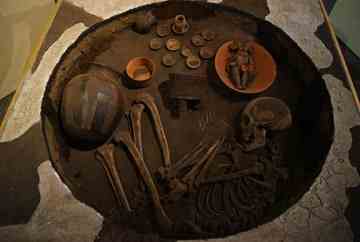Most recent findings registered at the southwest part of the Archaeological Zone of Teotihuacan, Estado de Mexico, are presented for the first time in the exhibition La Ventilla, un barrio de la ciudad antigua de Teotihuacan (La Ventilla, a Neighborhood in the Ancient City of Teotihuacan) at the Ex Site Museum of the archaeological site.
 The display of 120 pieces reveals the way dwelling areas of Teotihuacan were organized. La Ventilla neighborhood was occupied 1,400 years ago in an early age, from Miccaotli (200 AD) to Metepec phase (550-650 AD). For almost 2 decades, specialists from the National Institute of Anthropology and History (INAH) have recovered a great amount of archaeological material, mural paintings and more than 300 human burials.
The display of 120 pieces reveals the way dwelling areas of Teotihuacan were organized. La Ventilla neighborhood was occupied 1,400 years ago in an early age, from Miccaotli (200 AD) to Metepec phase (550-650 AD). For almost 2 decades, specialists from the National Institute of Anthropology and History (INAH) have recovered a great amount of archaeological material, mural paintings and more than 300 human burials.
Explorations leaded by archaeologist Ruben Cabrera Castro, have allowed knowing the characteristics of Teotihuacan neighborhoods’ organization. According to investigations, farmers and artisans specialized in feather, stone and shell crafts inhabited La Ventilla.
Censers, vessels, flat bowls and figurines; greenstone beads, shell accessories, sculptures and skeletons, as well as scale models of murals integrate the exhibition organized by INAH, to be open until September 30th, 2010.
“The objective of the sample is to explain how Teotihuacan functioned social, economical and urbanely through neighborhoods”, explained archaeologist Veronica Ortega, sub director of the archaeological zone.
“The most representative neighborhood was La Ventilla: we have found blocks limited by streets, a complex hydraulic system, architecture of different categories, such as the plaza, public buildings, temples, dwelling areas and spaces devoted to crafts production”.
The first section shows how the Prehispanic suburb was integrated. Models and drafts of some architectural conjuncts are displayed.
The second section is about the importance of buildings dedicated to the cult, which were decorated with mural paintings that present symbols of human sacrifice.
The module related to administration represents the space occupied by hierarchy. “This area is integrated by buildings with magnificent mural paintings, such as the Patio of Jaguars”, mentioned Veronica Ortega.
The fourth section gathers pieces that give account of the domestic life and craftsmanship by displaying vessels, fat bowls, censers, ceramic masks and anthropomorphic figures as well as tools to create them.
The recreation of 3 burials will be exhibited to give account of the funerary tradition at Teotihuacan.
The last hall gives a general panorama of the government structure in the neighborhood during 200 to 600 AD, concluded the archaeologist.
La Ventilla, un barrio de la ciudad antigua de Teotihuacan will be open from July 23rd to September 30th 2010, Tuesday to Sunday from 8:00 to 17:00 hours at the Ex Museo de Sitio Gate 1 of Teotihuacan Archaeological Zone.
The 51 MXP admission fee includes the entrance to the archaeological site and the museums. Children under 13, students, teachers and senior citizens with valid ID do not pay. On Sundays, Mexican citizens and residents do not pay.